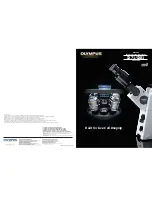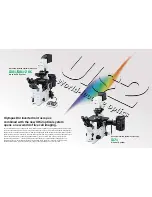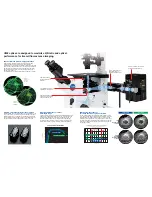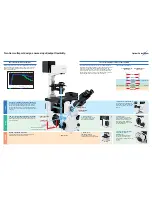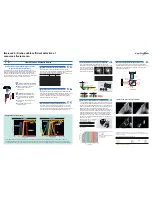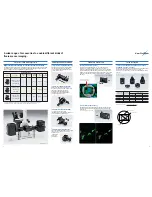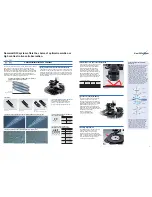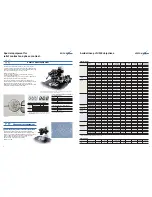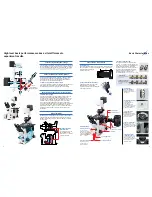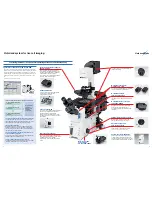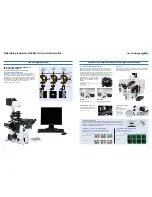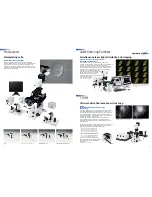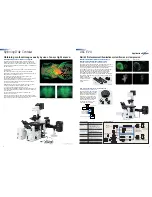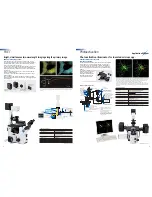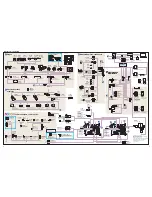
16
15
Light adjustment dial
Focus knob
TTL Pulse control switch
ON/OFF switch for the
motorized shutter (e.g.
made by UNIBLITZ).
Light path selection lever
Two-stage selection
between the observation
tube and the left side port.
This big lever prevents
operation errors in the dark
room.
Power ON/OFF switch
Aperture stop (A.S.)
Field stop (F.S.)
Shutters for
fluorescence excitation
[ Frontal control ]
High level basic performance makes a vital difference to
experiment results.
[ Compact body ]
Compact body design allows wide port space for both left and right
sides, the bottom and on the back. It allows you to use the variety
of peripherals with offering an
excellent operability.
290
135
394
245
[ Tilting binocular tube/U-TBI90 ]
A tilting observation tube with 35-85°
elevation angle. This tube offers
ergonomic operation for both sitting and
even standing position.
[ Focus free collection ring ]
The newly developed LUCPLFLN40X (N.A.
0.6, W.D. 3.4 mm*) and LUCPLFLN60X (N.A.
0.70, W.D. 1.5-2.2 mm) are compatible with
various container thickness. Turning the
correction ring does not blur the focus when
correcting spherical aberration caused by
different container thickness. A simple
correction operation optimizes the
observation image.
* When using 1 mm thickness container.
■
LUCPLFLN 40X
Operating the correction ring does
not blur the focus.
■
When using a conventional
objective with correction ring
Focus blurs when correction ring
is operated.
[ Oil immersion
protection function ]
Prevents immersion oil
infiltrating through the tip of
the objective.
[ Fluorescence turret
confirmation window ]
The fluorescent mirror unit
can be confirmed from the
space between the left and
right eyepieces of the
observation tube.
[ Fluorescence indicator ]
Bright,easy-to-see self-
illuminated labels are used
to denote fluorescence filter
sets, easily visible in a dark
room.
[ Glass stage insert
plate/IX2-GCP ]
The objective type and its
magnifications can easily be
recognized through this
glass stage insert.
[ Magnification changer ]
This intermediate
magnification changer
offers different
magnification without
switching the objective lens.
1.6X is standard (IX71/81)
and 2.0X is optional.
In addition to maximizing rigidity of IX2 microscope frame, Olympus
simplified or shortened mechanical structures from the focusing
handle to the revolving nosepiece, thereby achieving to minimize
the focus drift.
In order to minimize light loss from reflection, a simple V-shaped
optical system is employed. This restricts reflection inside the
microscope to one-time-only, reducing light loss and allowing
observation of even weak fluorescent signals.
■
Thermally compensated relay lens optics
Used for the observation optical path, thermally-compensated relay
lens optics involve combining lenses with different thermal
characteristics to offset blurs caused by temperature change.
■
External power supply
Time-lapse observation over a long period will cause some heat
strain to the microscope, from temperature changes in the
environment and air blown from an air-conditioner. Because such
changes can cause blurring, the IX2 series design focuses on its
structure in order to maximize rigidity and equips the external
power supply for transmitted illumination on the outside of the
microscope. Thereby IX2 series archives the highest level of thermal
expansion compensation. Various accessories are provided to
stabilize long-term time-lapses, such as an incubator that reduces
temperature changes in the environment and the effects of air
conditioning.
Since the UIS2 optical system is compensation-free (i.e. compensa-
tion is performed only by the objective lens), a clear primary image*
can be captured through any camera port offering from IX2 system.
* The "primary image" is the first image created by convergence of the luminous flux after passing
through an objective. There is no loss in light quantity and no image deterioration.
Capture of high-clarity primary image
V-shaped optical path to reduce light loss
Against thermal expansion to prevent defocusing
High body rigidity
Revolving nosepiece
guide structure
The shorter section in red,
the less influence from
heat and force — resulting
in improved rigidity.
Thermally
compensated
relay lens optics
Ease of use in a compact body
Basic Characteristics
(Unit: mm)

